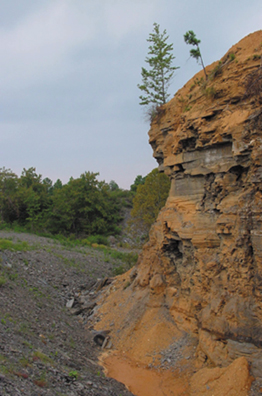
Geotimes Home | AGI Home | Information Services | Geoscience Education | Public Policy | Programs | Publications | Careers

 Vertebrate —
amphibian or maybe early reptile — tracks from the Carboniferous period.
Photograph by Andrew Rindsberg, Geological Survey of Alabama.
Vertebrate —
amphibian or maybe early reptile — tracks from the Carboniferous period.
Photograph by Andrew Rindsberg, Geological Survey of Alabama. But the wall
sits on land a local farmer, Joseph Pugh, has a contract to buy from the mining
company if the land is reclaimed. He owns the already-reclaimed mine land and
grazes livestock there. He wants the mining company to finish reclamation, as
mandated by the Surface Mining Control and Reclamation Act of 1977, which would
eliminate the hazard of the highwall to his animals. This means bulldozing and
burying the site.
But the wall
sits on land a local farmer, Joseph Pugh, has a contract to buy from the mining
company if the land is reclaimed. He owns the already-reclaimed mine land and
grazes livestock there. He wants the mining company to finish reclamation, as
mandated by the Surface Mining Control and Reclamation Act of 1977, which would
eliminate the hazard of the highwall to his animals. This means bulldozing and
burying the site.  |
Geotimes Home | AGI Home | Information Services | Geoscience Education | Public Policy | Programs | Publications | Careers |